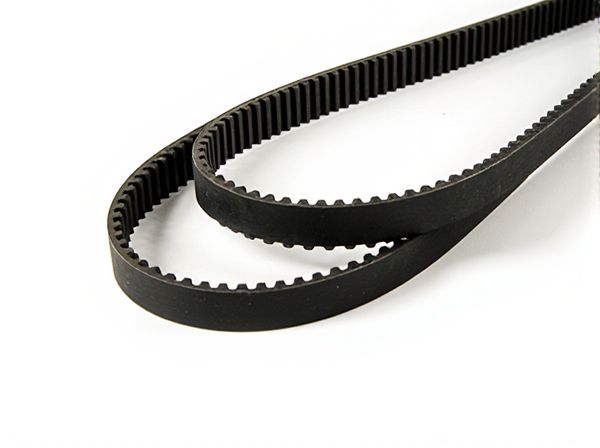
Photo illustration: Single Row Timing Belt vs Double Row Timing Belt
Single row timing belts offer simplicity and lighter weight, making them ideal for applications requiring moderate power transmission and smooth operation. Double row timing belts provide increased strength and durability, handling higher loads and enhancing reliability in demanding environments. Your choice depends on the required torque capacity and space constraints, balancing performance with design needs.
Table of Comparison
| Feature | Single Row Timing Belt | Double Row Timing Belt |
|---|---|---|
| Structure | One row of teeth | Two rows of teeth |
| Durability | Moderate lifespan, suited for standard use | Higher durability, ideal for heavy-duty applications |
| Load Capacity | Lower load capacity | Increased load capacity, better torque handling |
| Noise Level | Quieter operation | May produce more noise due to doubled teeth engagement |
| Cost | Generally less expensive | Higher cost due to enhanced design |
| Application | Suitable for most passenger vehicles | Used in high-performance and heavy-duty engines |
| Maintenance Interval | Typically 60,000 to 100,000 miles | Extended intervals, often exceeding 100,000 miles |
Introduction to Timing Belts
Timing belts are essential components in internal combustion engines, ensuring precise synchronization between the crankshaft and camshaft(s) to maintain optimal engine performance. Single row timing belts feature one set of teeth meshing with the pulleys, providing sufficient strength and durability for standard applications, while double row timing belts have two parallel rows of teeth, offering enhanced load capacity and increased resistance to wear in high-performance or heavy-duty engines. Understanding the differences in construction and application helps in selecting the appropriate timing belt for specific automotive or industrial needs.
What is a Single Row Timing Belt?
A single row timing belt features a single line of teeth designed to synchronize the camshaft and crankshaft in internal combustion engines, ensuring precise valve timing and efficient engine performance. Made from durable materials like neoprene or hydrogenated nitrile rubber with fiberglass or Kevlar reinforcement, single row belts offer flexibility and high resistance to wear and heat. This type of belt is commonly used in automotive engines where space constraints and moderate power transmission demands are present.
What is a Double Row Timing Belt?
A double row timing belt features two parallel rows of teeth, providing enhanced strength and durability compared to a single row timing belt. This design improves load distribution and reduces the risk of belt slippage or failure in high-torque or heavy-duty engine applications. Double row timing belts are commonly used in high-performance vehicles and industrial machinery where reliable synchronization between camshaft and crankshaft is critical.
Key Differences Between Single and Double Row Timing Belts
Single row timing belts consist of a single row of teeth, offering precise synchronization and are suitable for applications requiring less load capacity. Double row timing belts feature two parallel rows of teeth, providing increased strength, better load distribution, and enhanced durability for heavy-duty or high-torque engines. The key differences lie in their structural design, load-bearing capacity, and application suitability, with double row belts generally supporting more demanding mechanical systems.
Performance and Efficiency Comparison
Single row timing belts offer lightweight design and reduced friction, resulting in efficient power transmission suitable for low to moderate load applications. Double row timing belts deliver enhanced performance by providing increased tensile strength and improved load distribution, ideal for high-demand environments requiring durability. The choice between single and double row belts impacts overall system efficiency, with double row belts maintaining stability under heavier loads but potentially increasing rotational mass.
Durability and Lifespan Considerations
Single row timing belts generally offer sufficient durability for standard automotive and industrial applications but can wear out faster under high stress or heavy load conditions compared to double row timing belts. Double row timing belts feature enhanced strength and stability due to their dual rows of teeth, providing improved load distribution that significantly extends lifespan and reduces the risk of belt failure. In high-torque environments, double row timing belts are preferred for their superior resistance to elongation and wear, resulting in longer service intervals and increased engine reliability.
Application Suitability and Industry Use Cases
Single row timing belts are ideal for lightweight automotive engines, small machinery, and textile equipment where precision and cost-efficiency are crucial. Double row timing belts offer higher torque capacity and enhanced durability, making them suitable for heavy-duty industrial applications like agricultural machinery, construction equipment, and large-scale conveyor systems. Industries prioritize single row belts in compact, low-load settings, while double row belts dominate in environments demanding robust performance and extended service life.
Installation and Maintenance Requirements
Single row timing belts offer simpler installation due to their narrower design, which allows easier alignment and reduced tension adjustments compared to double row timing belts. Double row timing belts require more precise installation as the dual rows necessitate parallel alignment to prevent uneven wear and potential belt failure. Maintenance for single row belts typically involves straightforward inspection and replacement cycles, whereas double row belts demand more frequent checks for wear consistency across both rows and may require specialized tools for tensioning and alignment.
Cost Analysis: Single vs Double Row Timing Belts
Single row timing belts generally offer a more cost-effective solution due to lower material usage and simpler manufacturing processes, making them ideal for light to moderate load applications. Double row timing belts, while more expensive upfront, provide enhanced durability and load distribution, which can reduce maintenance costs and downtime in heavy-duty or high-torque environments. Evaluating total cost of ownership should balance initial purchase price against expected lifespan and performance requirements for optimal investment.
Choosing the Right Timing Belt for Your Needs
Choosing the right timing belt depends on the application's load capacity and durability requirements. Single row timing belts provide sufficient performance for light to moderate loads, offering simplicity and cost-effectiveness. Double row timing belts deliver enhanced strength and longer lifespan, making them ideal for heavy-duty machinery and high-torque environments.
 caratoz.com
caratoz.com